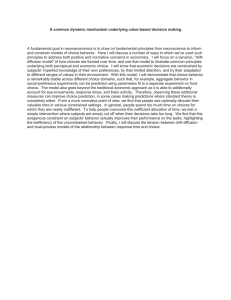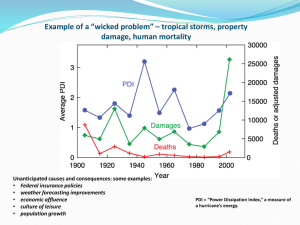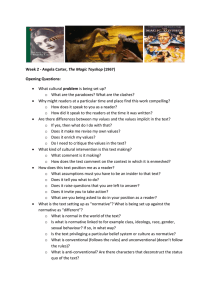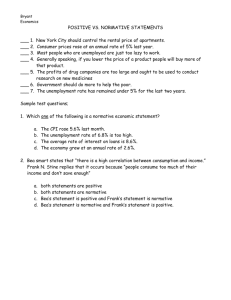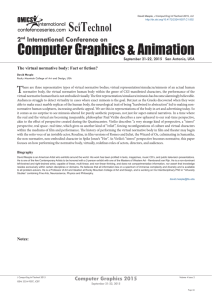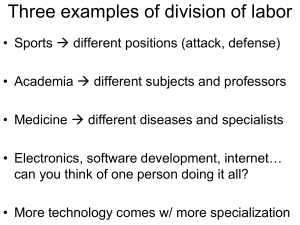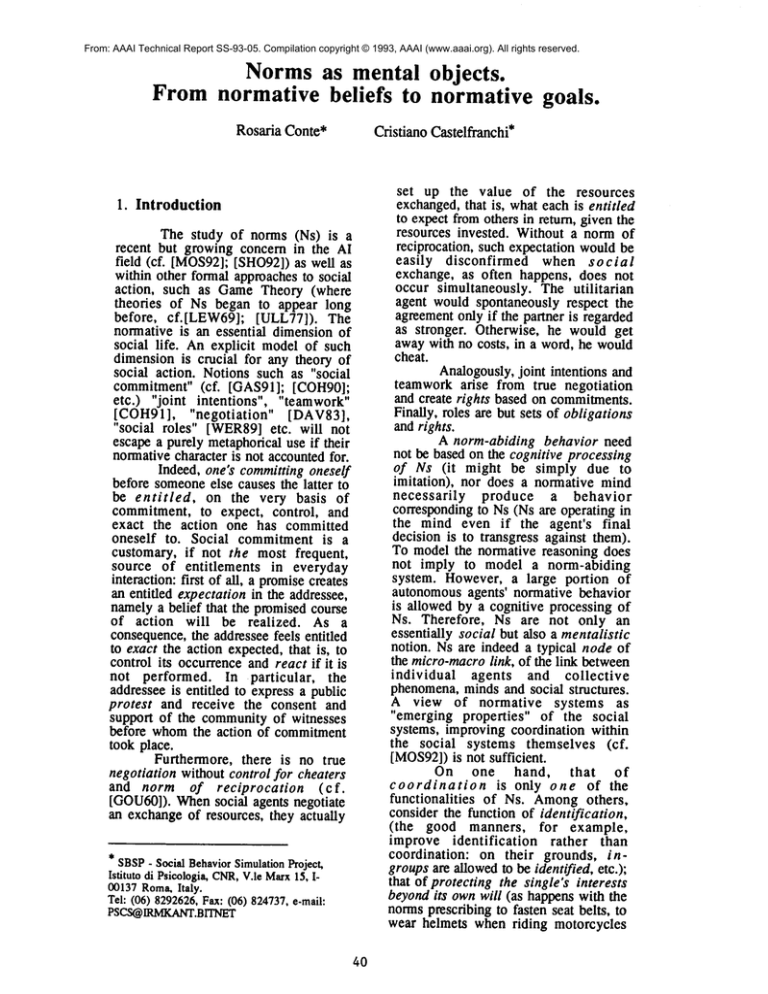
From: AAAI Technical Report SS-93-05. Compilation copyright © 1993, AAAI (www.aaai.org). All rights reserved.
Norms as mental objects.
From normative beliefs to normative goals.
RosariaConte*
Cristiano Castelfranchi*
1. Introduction
The study of norms (Ns) is
recent but growing concern in the AI
field (cf. [MOS92];[SHO92])as well
within other formal approaches to social
action, such as Game Theory (where
theories of Ns began to appear long
before, cf.[LEW69]; [ULL77]). The
normative is an essential dimension of
social life. An explicit model of such
dimension is crucial for any theory of
social action. Notions such as "social
commitment" (cf. [GAS91]; [COH90];
etc.) "joint intentions",
"teamwork"
[COH91], "negotiation"
[DAV83],
"social roles" [WER89]etc. will not
escape a purely metaphorical use if their
normative character is not accounted for.
Indeed, one’s committing oneself
before someoneelse causes the latter to
be entitled,
on the very basis of
commitment, to expect, control, and
exact the action one has committed
oneself to. Social commitment is a
customary, if not the most frequent,
source of entitlements
in everyday
interaction: first of all, a promisecreates
an entitled expectation in the addressee,
namely a belief that the promised course
of action will be realized.
As a
consequence, the addressee feels entitled
to exact the action expected, that is, to
control its occurrence and react if it is
not performed. In particular,
the
addressee is entitled to express a public
protest and receive the consent and
support of the community of witnesses
before whomthe action of commitment
took place.
Furthermore, there is no true
negotiation without control for cheaters
and norm of reciprocation
(of.
[GOU60]). Whensocial agents negotiate
an exchange of resources, they actually
SBSP
- Social BehaviorSimulationProject,
Istituto di Psicologia,CNR,
V.le Marx15, 100137Roma,Italy.
Tel: (06) 8292626,Fax: (06) 824737,e-mail:
PSCS~IRMKANT.BITNET
40
set up the value of the resources
exchanged, that is, what each is entitled
to expect from others in retum, given the
resources invested. Without a norm of
reciprocation, such expectation would be
easily
disconfirmed
when social
exchange, as often happens, does not
occur simultaneously. The utilitarian
agent would spontaneously respect the
agreement only if the partner is regarded
as stronger. Otherwise, he would get
away with no costs, in a word, he would
cheat.
Analogously, joint intentions and
teamwork arise from true negotiation
and create rights based on commitments.
Finally, roles are but sets of obligations
and rights.
A norm-abiding behavior need
not be based on the cognitive processing
of Ns (it might be simply due to
imitation), nor does a normative mind
necessarily
produce a behavior
corresponding to Ns (Ns are operating in
the mind even if the agent’s final
decision is to transgress against them).
To model the normative reasoning does
not imply to model a norm-abiding
system. However, a large portion of
autonomous agents’ normative behavior
is allowed by a cognitive processing of
Ns. Therefore,
Ns are not only an
essentially social but also a mentalistic
notion. Ns are indeed a typical node of
the micro-macrolink, of the link between
individual
agents and collective
phenomena, minds and social structures.
A view of normative
systems as
"emerging properties"
of the social
systems, improving coordination within
the social systems themselves (cf.
[MOS92])is not sufficient.
On one hand,
that
of
coordination
is only one of the
functionalities
of Ns. Amongothers,
consider the function of identification,
(the good manners, for example,
improve identification
rather than
coordination:
on their grounds, ingroups are allowed to be identified, etc.);
that of protecting the single’s interests
beyond its own will (as happens with the
norms prescribing to fasten seat belts, to
wear helmets when riding motorcycles
etc.) Furthermore,there are at least two
types of norms of coordination: those
whichare aimedat improvingthe agents’
performances(like the traffic norms),
and those which are intended to reduce
displayed aggression (like the normof
reciprocation).
On the other hand, the
emergenceparadigmgives an account of
conventional norms and conforming
behaviors (cf. [BIC90]), but leaves
unexplainedthe prescriptive characterof
norms. Within the game-theoretic
paradigm,a social normis defined as an
equilibrium, a combinationof strategies
such that "each maximizeshis expected
utility by conforming,on the condition
that nearly everybodyelse conforms to
the norm." (cf. [BIC90: 842]) Social
norms are defined as behavioral
regularities
which emerge from the
strategic agents’ choices to conform.
This is an account of the spreading of
certain behaviors over a population of
strategic agents, in a word, a modelof
social conventions. However, such a
model does not account for a crucial
aspect of the normative mechanism,
which plays a role in the spreading of
normative behaviors,
namely the
normativerequest. Whatis lacking in the
game-theoretic
definition
aforementioned is a reference to the
agent’s will that others conformto the
norms.A social norm, indeed, is such if
it is associated at least with a general
wantthat it be observed. Sucha wantis
usually conveyed in manyways: from
simple expectations (note that the term
expectation is often used to refer to a
hybrid mental object,
namely a
goal/belief: if you expect the weather
tomorrow to be sunny and warm you
both believe and wish it to be so), to
explicit commandsand requests; from
implicit disapprovalof transgressors, to
explicit reproachetc..
Therefore, here it is intended to
drawthe attention on both the following
aspects:
¯ the prescriptive character of Ns,
that is, their role in controlling and
regulating the behaviors of agents
subject to them;
¯ a need for a mentalistic notion of
Ns allowing cognitive agents to
becomenormative agents as well. Ns
are not yet sufficiently characterized
as mentalobjects (cf [SHO92]).Here,
some crucial problems concerning
the mentalnature of Ns will be raised
41
and someinitial solutions proposed.
Theproblemsare the following:
- Howare Ns represented in the
agents’ minds? Should they be
seen as a specific mental object,
and if so, whichone?
- Whichrelation do they bear with
beliefs and goals? Howcan they
regulate the agents’ behaviors?
- Howis their prescriptive (and not
simply conventional) character
(that is, a moreor less explicit
request and the corresponding
duty) expressed?
- Whydoes an autonomousagent
complywith norms,thus fulfilling
others’ expectations?
2. Thenormativecoin.
What is a norm in an agent’s
mind?This question leaves aside another
fundamentalquestion, namely what is a
Ntout court. Althoughprioritary, wewill
not face this question here (however,see
[CAS91]).Therefore, wewill not try to
answerthe question what the "external"
side of Ns is, namely, how Ns are
encountered in social life, which
functionalities they have, whichfeatures
define de facto (independentof agents’
beliefs) a normativesource, etc..
Here, we will focus exclusively
on the "internal" side of Ns, that is:
Whichcognitive role do Ns play in the
agents’ minds and in which format are
they represented? Whatkind of mental
object is a N?Whatis a normativesource
in the agents’beliefs?
There are at least two distinct
ways in which norms can be
implemented on a computer system: as
built-in functioningrules and constraints
(like productionrules) or as explicit and
specific mentalobjects (i.e. obligations,
duties, etc.) distinct from, say, goals and
beliefs. Of course, there might be
intermediate solutions: for example,and
in line with the game-theoreticview, one
might think of noms as a way of
describing the behaviors of strategic
agents in interaction: no specific
normativeobject is implementedin those
agents’ mindsalthough cognitive action
is allowed.Afurther alternative consists
of implementingNs just as goals, namely
final ends: In this case, cognitive agents
wouldbe allowed to choose amongtheir
(competing) goals (instead of simply
applying procedures and routines) but
they wouldtreat Ns as any other goal of
theirs.
At least two undesirable
consequences seem to derive from the
latter eventuality: the observance of Ns
would come to depend exclusively upon
the agents’ subjective preferences, and
there would be no social control and
influencing.
To implement norms as
specific mental objects, although a costly
alternative, is required in a cognitive
modelling approach to social agenthood,
in which the present work is framed.
Moreover, the cognitive regulatory
endowment of the human species has
undoubtedly profited by the explicit
representation of norms. A crucial but
difficult task, beyond the scope of the
present work, would then be to explore
these advantages and confront them with
those of all alternatives considered.
Our language
draws
on
[COH90]’smodel for describing rational
interaction. For the readability of the
paper, let us provide the semantics of the
main predicates
used and the axiom
(A1) here called the axiom of goalgeneration (for further analysis, see
[COH90], [CON91a], [CON91b]):
the future behavior of the agents subject
to them, their addressees (As).
To this end, they ought to give
rise to some new goal in an A’s mind
(cfr. [CON91b]): for autonomous agents
to undertake (or abstain from) a course
of action, it is not sufficient that they
knowthat this course of action is wanted
(by someone else) (cf. [ROS88];
[GAL90]). It is necessary that these
agents have the goal to do so. Norms
may act as a mechanism of goalgeneration. Indeed, they represent a
powerful mechanism for inducing new
goals in people’s minds in a cognitive
way. Howis this possible?
At first,
Ns need being
represented as beliefs in an A’s mind. Let
us start from beliefs about requests. A
simple request, before succeeding and
producing acceptance on the side of the
required person, is nothing but a belief,
namely a belief about someone’s will.
Such a belief can be expressed as
follows:
(BELx (GOALy (GOALx p)))
a:
p andq:
v:
x ,y, andz
(BELxp):
(GOAL
x p):
action;
states of the world;
a worldstatepositivelyvalued;
single agents;
x hasp as a belief
x wantsthat p is true at some
pointin the future.
(OUGHTp):
an obligationconcerning
any
givenpropositionp;
(DONE
x a) = def (DONE
a) A(AGT
actiona has beendoneby
agentx;
Op
p is true at somepointin the
future.
((GOALxp)^(BELx(q~Op)))~
O(GOAL
x q)
ifx wantsp andbelievesthat
if q thanp will follow,thenx
will wantthat q aswell.
(OBTAIN
x p)=def(GOAL
x p) AO
(BELx p))
x obtainsp iff p is a goal
of x’s andlater it will be
true andx will believeso.
(GOAL-CONFL
x y p q)=def
(GOAL
x p) A (GOAL
y
^(p vq)
goalswhichconsistof
incompatiblepropositionsare
in conflict.
(1)
whereagent x believes someone else,
agent y, has the goal that x has the goal
that p. Morespecifically, x believes that
what y requires of her is to do an action
planned for p:
(BELx (GOALy ((DONEx a))).
(2)
Now,two questions arise here:
1. what is the difference, if any,
betweenthis type of belief, that is, a
belief about an ordinary will, and a
belief
about a normative
or
prescriptive
will? Is a N always
represented in people’s minds as an
expression
of some particular
external will?
2. how do we go from a belief about
a normative will to the goal to
complywith it, that is, to a normative
goal?
Starting
from the former
question, one could say, that normative
beliefs are beliefs about a general will
affecting a class of agents. This equals to
saying that there is a class of agents
wanting some of them to accomplish a
given action. This view is interesting and
fits rather well the DAI field, where
attention is now increasingly paid to
shared mental states and collective action
([GRO90]; [LEV90]; [COH91], etc.; for
2.1. Thenormativebelief.
Ns are generally considered as
prescriptions,
directives,
commands.
Even when expressed in any other type
of speech act they are meant to "direct"
42
review and further
analysis,
see
[RAO92]). However, it presents two
drawbacks.
First, it relies upon a notion of
collective
or group’s will as yet
fundamentally distributive. In [RAO92],
for instance, a social agent’s wants and
beliefs are defined as the conjunction of
goals and beliefs
of the group’s
members. The authors contrast this with
the opposite view (held, for instance, by
[SEAg0])of social entity as "irreducible"
to their members.An alternative to both
views exists,
namely to say that
individuals form a collective entity if
they objectively depend on one another
to achieve one and the same goal or
interest (the latter being defined in
[CON91a]as a worldstate neither wanted
nor believed by the agents involved
which nonetheless implies the future
achievement of (one o0 their goals).
Furthermore, the group may achieve its
common goal, or realize its common
interest, by distributing tasks amongits
members. However, the task assignment
may be accomplished by a specialized
subcomponent of the group. In other
words, the notion of group will can be
"reduced" to the mental states (of some)
of its members without necessarily
supposing shared goals, or even joint
intentions,
Secondly,
and moreover,
a
normative belief seems to be grounded
on something more than a general will.
In particular, what seemsto be implied is
a notion of obligation, or duty. In this
perspective, let us express the general
form of a normative belief as follows:
(N-BELx Yi a) =def
( Ai.I~,(BEL x (OUGHT
(DONEYi a)))))
where (OUGHT
(DONEYi a)) stands for an
obligation for a set of agents Yi to do
action a. The question is: what relation
does (3) bear with belief type (2)? This
relation seems possible thanks to the
notion of normative will. In other terms,
a normative belief implies a belief about
the existence of a normativewill:
(N-BEL x Yi a)~
(4)
coincide with the whole superset Yi. In’
the latter case, the normative "will
coincides with the group’s will. But this is
not necessary. Suffice it to say that, in a
normative belief,
a subcomponent
(individual or sociall) of the group
mentioned to issue a request. In x’s
belief, what makesa request normative is
the very fact that a given z is believed to
want that Yi have an obligation to do a.
To be noted, what is here
proposed is a notion of abstract
obligation, one which goes beyond any
personal (or supposedly such) will. In
coercion, for example, the coercive agent
does not (nor is believed to) have the
goal that the coerced agent believes in an
abstract obligation to do something. All
he needs is to persuade other that she is
forced (namely threatened) to do what
the coercive agent wants. On the
contrary, a normative will is believed to
create a mental state of abstract
obligation, independent of any personal
want or need. In other words, z is not
(believed to be) happy with yi’s doing a
in virtue of z’s personal request (be it
coercive or not). By default a normative
will is one which wants you to have an
obligation to do something, and not
simply the corresponding goal.
Furthermore, a normative will is
usually believed in turn to be grounded
on norms, to be norm-based. More
specifically, a strong sense of normative
will occurs whenthat will is characterized
as held to issue Ns:
(N-BELx Yi a)~
(5
:3z(BEL x(OUGHT(GOAL
z (OUGHT(DONE
Yi a)))))
A weaker or milder meaning is that of
entitled, or legitimate will, a legitimate
goal being defined as follows:
(L-GOAL
x p ) =def
(6)
Vy3q(GOAL-CONFL
x y p q)
(OUGHT--~GOAL y q))
in words: p is a legitimate goal of x’s iff
forall agents y that happen to have a
given goal q conflicting with p, y ends
up with having an obligation to give up
3z(BEL x (GOALz (OUGHT(DONEYl a))))
where z belongs to a higher level set of
agents yj’ of which Yi is a subset: An
agent x has a normative belief about
action a if x believes that someonewants
that it is obligatoryfor Yi to do a. This is
a minimal condition, since z might even
1 As in [RAO92],the definition of a social entity
should be recursive. Therefore, what has been said
with regard to the group at large applies to its
subcomponentsas well. In case z in turn is a
multi agent subcomponent,its will might be
shared or not amongits members.Its task (say, to
legiferate) might be accomplished in such a way
that not all membersshare the same goals.
q. In other words, a legitimate goal is
watchedover by a norm. In this sense,
rights and legitimacy are said to give
assistance to, and go to the rescue of,
those who cannot defend themselves
against
aggression
and cheat.
Consequently, an entitled will is that
which a norm protects
from any
conflictinginterest.
To sumup, for an agent to have
a normativebelief is sufficient to believe
that there is an obligationfor a givenset
of agents to do a given action. At a more
careful examination, however, the
obligationis believedto implythat:
- a givenaction is prescribed,that is,
requested by
society’s roles does not influence in any
relevant way her decisions. What is
neededfor an agent to regard herself as
subject to, addressedby, a givenN?
3.1. Thepertinencebelief.
First another belief is needed,
namely a pertinence belief: For x to
believe that she is addressed by a given
N, x needs to believe that she is a
member
of the class of As of that N:
(P-N-BEL x a) =def
(Ai=l,n (N-BELx Yi a)) A (Vj.I,n(BEL x (x
(7)
where P-N-BELstands for normative
belief of pertinence.
Now,x’s beliefs tell her not only
that there is an obligationto do action a,
but also that the obligation concerns
preciselyherself.
- a norm-basedwill, be it held to
issue that request, or simplyentitled
to do so.
Of course, a N-belief does not
implythat a deliberate issuing of a Nhas
in fact occurred. Social normsare often
set up by virtue of functional unwanted
effects. However,once a given effect is
believedto be a social norm,an entitled
will is also believedto be implied,if only
an anonymous one ("You are
wanted/expected
to (not) dothis...", "It
generally expectedthat...", "This is done
SO...", etc.).
This equals to saying that the
present modelof N-beliefs is recursive.
Arequest is believedto be normativeif it
ultimately traces back to some norm.
This is not to say that Ns are
"irreducible" objects. Of course, the
origins of Ns call for an explanation
which unavoidably brings into play the
community
of agents, their interests and
their interactional
practice (cf.
[ULL77]). However, in the agents’
representations there is no need for
keepinga record of such history. In the
agents’ beliefs a N is alwaysrepresented
as a legitimate, even a norm-driven,
prescription. Thepresent modeltries to
give an accountof this evidence.
3.2. Thenormativegoal.
Still, (7) is not much less
"descriptive" than (3). Wedo not see any
normativegoal, yet.
First, let us express a N-goalas
follows:
(N-GOALx a) =def
(P-N-BEL x a) A (GOALx (DONEx
A normative goal of a given
agent x aboutaction a is therefore a goal
that x happensto haveas long as she has
a pertinence normative belief about a.
Ultimately, x has a normativegoal in so
far as and because she believes to be
subject to a N. Therefore, a N-goal
differs, on one hand, from a simple
constrain which reduces the set of
actions available to the system (cf.
[SHO92]),and, on the other, from other
ordinary goals.
With regard to behavioral
constrains, a N-goalis less compelling:
An agent endowed with N-goals is
allowed to compare them with other
goals of hers and to someextent freely
choose whichone will be executed. Only
if endowedwith N-goals an agent may
legitimately be said to complywith, or
violate, a N. Onlyin such a case, indeed,
she maybe said to be truly normative.
Withregard to ordinary goals, a
N-goal is obviously more compelling:
whenan agent decides to give it up, she
knowsshe both thwarts one of her goals
3. Therouteof Ns in the mind.
Turning to question 2. raised
above, a normativebelief is only one of
the ingredients of normativereasoning.
Norms,indeed, are hybrid configurations
of beliefs andgoals. Actually, as defined
so far, a normative belief is only
descriptive: it does not "constrain" or
regulate the believer and his decisions.
Indeed, an observer’s description of a
44
and violates a N 2
Now, the question is: Howand
why does a N-belief come to interfere
with x’s decisions? Whatis it that makes
her "responsive" to the Ns concerning
her? What is it that makes a normative
belief turn into a normative goal?
3.2.1.
Goal- and norm-adoption.
1. Conditional Action
2.Instrumental Adoption
thanks to (AI)
3.Cooperative Adoption
thanks to (AI))
There seem to be several ways of
accounting for the process leading to
normative goals (N-goals) as well
several alternative waysof constructing a
N-agent. There also seems to be a
correspondence between the process
from a belief about an ordinary request
to the decision of accepting such a
request, which we called (el. [CON91b])
goal-adoption, and the process from a
N-belief to a N-goal, which by analogy
will be called here norm-adoption.
Goal-Adoption
Slavish
Norm-Adoption
Automatic
(BELx (GOAL
y (DONE
x a)))
0 (DONEx
a)
(P-N-BEL
x a) D0(IX)NE
Self-interested
Utilitarian
Vp3q.(BEL
x ((OBTAIN
y
0(OBTAIN
x q)))D
0(GOAL
x (OBTAIN
y p))
Va..qp.((P-N-BEL
x a)
(BELx ((DONE
x
O(OBTAIN
x p))))D
0(N-GOAL
x a)
Value-driven
Co-interested
a)A
Vp3q.(BELx((OBTAINy
p)D 0q))~ Va3q.((P-N-BELx
(BELx ((DONE
a) ~ Oq)))D
0(GOAL
x (OBTAIN
y p))
O(N-GOAL
x a)
with q’s being (in x’s beliefs)
with q’s being(in x’s beliefs)
commonly
wantedby x and y’
worldstate positively value by
both x andthe normative
source:
(BEL
x (q = v(xz)))
4. Terminal Adoption
withv standingfor anyvalue.
Kantian
Benevolent
(Ay=l,n (GOAL
(OBTAIN
y py)))
(Ax=I,n(N-GOAL
n(x)))
with
ax being
thesetofN-actions
withpybeingthe set of y’s goals. requiredof x
Table 1: The route of Ns in the mind.
In situation
1. (conditional
action), we find some sort of production
rule: in goal-adoption (G-A), anytime
request is received by a system endowed
with such a rule, a goal that a be done is
fired. Analoguously, in N-adoption (NA), anytime a N-belief is formed a N2 Intuitively, she givesupboththe expected
consequences
of the actionprescribed(any
worldstatesupposedly
convenientto the agentor
otherwisepositivelyvalued)andin addition
sustainsthe costs of N-transgression.
Although
required,a formaltreatmentof bothaspectsis
beyondthe scopeof this work.
45
goal is fired. Now,this is a rather cheap
solution: no reasoning and autonomy are
allowed. It is simple machinery that
could be of help in cutting short some
practical reasoning, but is insufficient as
far as the modelling of normative
reasoning is concerned. However, such a
rule seems to account for a number of
real-life situations. Think, as far as
slavish G-Ais concerned, of the habit of
giving instructions
when asked by
passengers, and in the case of automatic
N-A, of the routine of stopping at the
red light (of course, in situations 1, it is
hard to differentiate G-A from N-A).
In situations 2 (instrumental
adoption), greater autonomy is allowed:
adoption is subject to restrictions. In GA, on the base of this rule, x will selfinterestedly adopt only those of y’s goals
which x believes to be a sufficient
condition for x to achieve some of hers.
Typically, but not exclusively, this rule
depicts situations
of exchange. An
utilitarian N-Arule says that forall Ns, x
will have the corresponding N-goals if
she believes she can get something out
of complying with them. (Think of the
observance of Ns for fear of punishment,
need of approval, desire to be praised,
etc..)
Cooperative, or cointerested,
goal adoption occurs whenever an agent
adopts another’s goal to achieve a
commongoal. N-adoption is cooperative
whenit is value-driven, that is, whenthe
agent autonomously shares both the end
of the normand the belief that the latter
achieves that end. This type of N-Acan
be seen as some sort of moral
cooperation since the effect of the norm
is shared (in the N-addressee’s beliefs)
by the aaddressee and the normative
source.
The last situation is terminal
adoption. This is not a rule, but a metagoal which is defined, in the case of GA, as benevolent (x is benevolent with
regard to y whenshe wants the whole set
of y’s goals to be achieved), and, in the
case of N-A, "Kantian .... (x wants to
observe the whole set of Ns addressing
herself as ends in themselves).
In situation 1, the rule is a typical
production rule. Its output is an action.
In situations 2 and 3, the rules output
some specific goals. In the case of N-A,
the agent ends up with a new type of
goal, namely a normative goal.
As seen at the beginning, this
implies x’s belief that she is requested to
do a by a normative will. But it implies
two further beliefs as well, namely that
the normative source is not acting in its
own personal interests; and that other
agents are subject to the same entitled
request (in a normative belief, a set of
norm addressees is always mentioned).
Now,these further aspects play a relevant
role, especially within the process
leading from N-goals to N-actions.
AN-goal, in fact, is not sufficient
for an agent to comply with a N. Several
factors occurring within the process
leading from N-goals to N-actions might
cause the agent to abandon the goal and
transgress against the norm. Amongthe
others (more urgent conflicting goals;
low expected chances of being caught
red-handed, etc.), what is likely to occur
is a confrontation with other As of a
given N. As known, a high rate of
transgressions
observed discourages
one’s compliance. Viceversa, and for the
samereason, it is possible to showthat if
one has complied with a given N, one
will be likely to influence other agents to
do the same (normative equity). Indeed,
it can be argued (cf. [CON92]) that
normative influencing plays a rather
relevant
role in the spreading of
normative behavior over a population of
autonomous agents.
4. Conclusive
research
remarks and future
In this paper, the necessity of a
cognitive modelling of norms has been
argued. It is proposed to keep distinct
the normative choice from any normlike behavior, that is that behavior which
appears to correspond to norms. Such a
difference is shown to be allowed only
thanks to a theory of norms as a twofold object (internal, that is, mental and
external, or societal).
Some instruments, still rather
tentative,
have been proposed for a
formal treatment of the "internal side" of
Ns. In particular,
a view of Ns as a
complex mental object
has been
attempted. This object has been shownto
consist
of other more specific
ingredients, namely goals and beliefs.
Two notions of normative belief and
goal have been provided and discussed,
and aspects of the process of normadoption examined and confronted with
the process of adopting another agent’s
goals.
Acknowledgement
Wewould like to thank Dr. Gianni Amati
for his helpful reading the paper.
References
[BIC90] Bicchieri,
cooperation. Ethics,
861.
C Norms of
100, 1990, 838-
[CAS91] Castelfranchi, C. & Conte, R.
Problemi di rappresentazione mentale
delle norme. Le strutture della mente
normativa, in R. Conte (ed.) La norma.
Mente e regolazione sociale.
Roma,
Editori Riuniti, 1991, 157-193.
46
[COH90]Cohen, P. R. & Levesque, H.
J. Persistence,
Intention,
and
Commitment, in P.R Cohen, J. Morgan
& M.A. Pollack (eds.) Intentions in
Communication. Cambridge, MA, MIT,
1990.
Artificial
94 -99.
[COH91] Cohen, P. & Levesque, H.J.
Teamwork.. TR-SRIInternational, 1991.
[MOS92] Moses, Y. & Tennenholtz, M.
On Computational Aspects of Artificial
Social Systems. Proc. of the 11th DAI
Workshop, Glen Arbor, February 1992.
Intelligence (AAAI-90), 1990,
[LEW69] Lewis, D. Convention.
Cambridge, MA. Harvard University
Press, 1969.
[CON91a]Conte, R. & Castelfranchi, C.
Mind is not enough. Precognitive bases
of social action. In N. Gilbert (ed.),
Proceedings of the Simulating Societies
Sympsium ’92, London, UCLPress, in
press; TR-IP-PSCS,1991.
[RAO92]Rao, A. S., Georgeff, M.P., &
Sonenmerg, E.A. Social plans:
A
preliminary report, in E. Wemer& Y,
Demazeau(eds.) Decentralized AI - 3.
North Holland, Elsevier, 1992.
[CON91b] Conte, R., Miceli,
M. &
Castelfranchi, C. Limits and levels of
cooperation. Disentangling various types
of prosocial interaction. In Y. Demazeau
& J.P. Mueller (eds.) Decentralized AI-2.
North-Holland, Elsevier, 1991, 147-157.
[ROS88] Rosenschein,
J.S.
&
Genesereth, M.R. Deals among rational
agents, in B.A. Huberman (ed.) The
ecology of computation. North-Holland,
Elsevier, 1988.
[CON92]Conte, R. & Castelfranchi, C.
Minds and Norms: Types of normative
reasoning. In C. Bicchieri & A. Pagnini
(eds.), Proceedings of the 2nd Meeting
on "Knowledge, Belief, and Strategic
Interaction",
Cambridge University
Press, in press; TR-IP-PSCS,1992.
[SEA90] Searle,
J.R. Collective
intentions and actions, in P.R. Cohen, J.
Morgan, & M.E. Pollack
(eds.)
Intentions
in communication.
Cambridge, MA,MITPress, 1990.
[SHO92] Shoham, Y. & Tennenholtz, M.
Onthe synthesis of useful social laws for
artificial agent societies. Proc. of the
AAAI Conference, 1992, 276-281.
[DAV83] Davies,R.
& Smith P.G.
Negotiation as metaphor for distributed
problem-solving. Artificial Intelligence,
20, 1983, 63-109.
[ULL77] Ulman-Margalit,
E. The
emergence of norms. Oxford, Clarendon,
1977.
[GAL90]Galliers, J.R. The positive role
of conflict in cooperative multi-agent
systems, in Y. Demazeau, & J.P. MueUer
(eds) Decentralized AI. North-Holland,
Elsevier, 1990.
[WER89]Wemer,E. Cooperating agents:
A unified theory of communication and
social structure,
in M. Huhns and L.
Gasser (eds.), Distributed artificial
intelligence,
Vol. 2, Kaufmann and
Pitman, London, 1989.
[GAS91] Gasser, L. Social conceptions
of knowledge
and action:
DAI
foundations and open systems semantics.
Artificial intelligenc, 47, 1991, 107-138.
[GRO90] Grosz, B.J. & Sidner, C.L.
Plans for discourse, in P.R. Cohen, J.
Morgan, & M.E. Pollack
(eds.)
Intentions
in communication.
Cambridge, MA,MIT Press, 1990.
[GOU60] Gouldner, A. The norm of
reciprocity: A preliminary statement.
American Sociological Review, 25, 1960,
161-179.
[LEV90]Levesque, H.J., Cohen, P.R., &
Nunes, J.H.T. On acting together. Proc.
of the Eighth National Conference on
47


